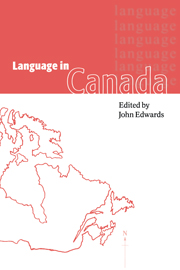Book contents
- Frontmatter
- Contents
- List of figures
- List of maps
- List of tables
- Notes on contributors
- 1 Canada
- Introduction
- 1 The foundations
- 2 The fading Canadian duality
- 3 Official bilingualism: from the 1960s to the 1990s
- 4 Official multiculturalism
- 5 Language in education: bridging educational policy and social psychological research
- 6 Aboriginal languages: history
- 7 Aboriginal languages: current status
- 8 French: Canadian varieties
- 9 French in Quebec
- 10 French in New Brunswick
- 11 French outside New Brunswick and Quebec
- 12 English: Canadian varieties
- 13 English Quebec
- 14 The teaching of international languages
- 15 French immersion in Canada
- 16 Language in Newfoundland
- 17 Language in Prince Edward Island
- 18 Language in Nova Scotia
- 19 Language in New Brunswick
- 20 Language in Quebec: aboriginal and heritage varieties
- 21 Language in Ontario
- 22 Language in Manitoba
- 23 Language in Saskatchewan: Anglo-hegemony maintained
- 24 Language in Alberta: unilingualism in practice
- 25 Language in British Columbia
- 26 Language in the Northwest Territories and the Yukon Territory
- Index of names
- Index of language families, languages, dialects
- Index of subjects
10 - French in New Brunswick
Published online by Cambridge University Press: 18 February 2010
- Frontmatter
- Contents
- List of figures
- List of maps
- List of tables
- Notes on contributors
- 1 Canada
- Introduction
- 1 The foundations
- 2 The fading Canadian duality
- 3 Official bilingualism: from the 1960s to the 1990s
- 4 Official multiculturalism
- 5 Language in education: bridging educational policy and social psychological research
- 6 Aboriginal languages: history
- 7 Aboriginal languages: current status
- 8 French: Canadian varieties
- 9 French in Quebec
- 10 French in New Brunswick
- 11 French outside New Brunswick and Quebec
- 12 English: Canadian varieties
- 13 English Quebec
- 14 The teaching of international languages
- 15 French immersion in Canada
- 16 Language in Newfoundland
- 17 Language in Prince Edward Island
- 18 Language in Nova Scotia
- 19 Language in New Brunswick
- 20 Language in Quebec: aboriginal and heritage varieties
- 21 Language in Ontario
- 22 Language in Manitoba
- 23 Language in Saskatchewan: Anglo-hegemony maintained
- 24 Language in Alberta: unilingualism in practice
- 25 Language in British Columbia
- 26 Language in the Northwest Territories and the Yukon Territory
- Index of names
- Index of language families, languages, dialects
- Index of subjects
Summary
INTRODUCTION
New Brunswick is the only officially bilingual province in Canada. Its French-speaking minority is the second largest, in absolute numbers, in a Canadian province (250,175 compared to 547,300 in Ontario), but it is by far the most important in terms of its proportion of the provincial population (34.6 per cent compared to 5.4 per cent for the Franco-Ontarians). As a group, New Brunswick francophones meet the four basic criteria identified by Allardt (1984) for the existence of a language minority: self-ascription or categorization by others as members of the group exists, an important majority of the group members are bound to the group by descent or ancestry, the language minority has some distinctive attributes (linguistic, cultural or historical traits) related to language and, finally, there is a structure of social interaction which allows the persistence of cultural differences.
Francophones have been present on the territory known from 1604 to 1710 as Acadie, then as Nova Scotia (1713 to 1783), and on which we now find the provinces of New Brunswick, Nova Scotia and Prince Edward Island, since the beginning of the seventeenth century (shortly after the establishment of the first French colony in North America on the Île Sainte-Croix in 1604 and of the first permanent French settlement at Port Royal in 1605).
- Type
- Chapter
- Information
- Language in Canada , pp. 202 - 225Publisher: Cambridge University PressPrint publication year: 1998
- 4
- Cited by



